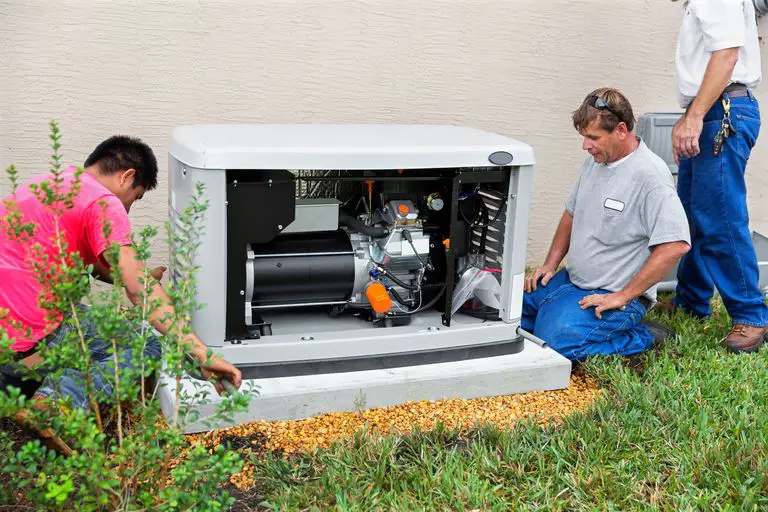We’ve all experienced power outages in our homes at some point in our lives. The feeling of dread as the lights go dark and you have to fumble in your drawers for a candle, while the dinner you’re halfway through preparing has started to go lukewarm.
It seems like you might just have to wait for the local authorities to send out their electricians to fix the power outage, which might take hours.
But with a portable generator, you can have the electricity in your house back up and running within minutes, leaving the neighbors scratching their heads and wondering why their lights are still off.
Intrigued? Well, before you rush out and pick up a generator from your nearest electrical appliances store, you’ll need to know to hook it up to your existing electrical system safely, as well as how to operate it and deal with any issues that might occur along the way.

The best question to ask yourself before hooking up an independent generator is: how are you going to be using it? That is, what are you planning on powering and how can you adapt your generator to power those loads.
How much generator power will you need to power the appliances and devices in your home? What equipment and techniques will you need to ensure that your generator is connected as safely as possible?
How can you make sure that your generator is running even in severe weather conditions?
Well, don’t worry, you don’t have to be an electrical wizard to master a basic generator, especially if you read our in-depth list of tips and tricks for connecting a generator to your home.
We’ll cover everything from transfer switches, carbon monoxide safety and the quality of the fuel you’ll be using.
How To Safely Use An Electrical Generator
When it comes to hooking up your portable generator, safety is certainly the most important aspect.
To determine what kind of generator and setup you’ll need, you’ll have to figure out what appliances you’ll be needing to power.
How Big Is Your Generator?
You’ll have to size up the generator so that it meets the required power loads of the devices that you intend to power in your house.
If you get a generator that isn’t up to the levels of power that you need then you could cause the electrics in your home to short out, which will damage them in the long run.
Make a list of the essential appliances that you’ll be running from your portable generator. You then need to make a note of their wattage, that is, the amount of power they’ll be needing.
A microwave typically uses 1500 watts of energy, whereas a refrigerator uses 1200 – 1500 watts, but they contain a capacitor that increases the wattage when the compressor begins. You can locate the wattage on the plug socket.
The power duration of your portable generator is usually on its body and it will give you the level of power that it will take to run on a single tank of fuel. Most generators will be able to run up to at least 24 hours.
Why Should You Use A Transfer Switch?
To guarantee a safe transfer of electricity from your portable generator to your home, you’ll need to run it in conjunction with a manual transfer switch.
This transfer switch will connect to your home via a thick cable called a gunset cord.
Electricity generated by your portable unit will run through this cord to a receptacle called the power inlet box on the outside of the house.
This will then run into the transfer switch and its circuit breakers to whatever circuits you need to power in your home.
The transfer switch is used for a few different reasons. One is that it separates all the circuits in your house that you will want to power with your generator.
This means that the other circuits in your house won’t be supplied with electricity, which will prevent overloading.
The transfer switch also separates the generator and the house from the general grid, which will stop the power that comes from your generator from feeding back into the grid and sparking a fire or injuring an electrician that has come to repair your neighborhood’s power outage.
The transfer switch will also stop any power coming from your neighborhood utility from traveling into your house once it has been repaired.
If this happens while the generator is running, then it could result in a power surge that will cause an electrical fire in your generator or, even worse, your home.
Use The Correct Heavy Duty Cords
If you don’t have the resources to install a transfer switch, then you can still power your fridge, your power tools or your computer by running long extension cords directly to the generator.
If you prefer this cheaper option, then you’ll need a cord that is heavy-duty enough to handle the power generated by your portable device.
A thicker gauge of wire will be able to handle the current running through them and should be rated for running exterior use.
You’ll want to ensure that your wires aren’t kinked or curled up to enable the smooth running of the electricity through the wiring.
This will be particularly important if you’re running a device with a higher wattage such as a portable heater. A coiled extension cord can get so hot that it melts.
You have to operate the power cords in the correct sequence to get them to run safely.
- Start the generator
- Plug the cord into the generator
- Go into your house and plug the loads into the extension cords
- When you want to disconnect your loads, repeat this process in reverse
- Turn the generator off
A Few Points On Carbon Monoxide
Generators produce a large quantity of carbon monoxide, which is why you should never operate one in an indoor environment such as a garage or a shed as you will run the risk of poisoning people in the immediate vicinity.
To this end, you will also want to make sure that the exhaust is facing away from the house. Also, if possible, you should aim the exhaust away from the home to reduce the risk of inhalation as much as you can.
You should secure your generator next to a sturdy structure or railing with a thick padlock and chain.
A lot of the portable generators are equipped with a built-in CO detector that will kill the machine if it exceeds its safety levels. If you have to pay an extra price for one of these, we suggest that you do.
How To Use Your Fuel Safely
Refueling a generator can be a dangerous process if not done properly. For example, it is very hazardous to try and refuel a generator that is still hot from the previous use.
Place your generator away from other heat sources such as a barbeque grill and make sure you don’t store the fuel nearby.
It is also crucially important that the muffler of your generator is completely cool before refueling, as it can take a little longer than the generator itself.
The muffler can get hot enough to melt plastic, so you might want to tap the muffler first before you place the tip of your fuel canister to the muffler.
Fuel is the lifeblood of your generator, so you should buy your fuel in bulk if you expect power outages for a few days.
You should store your fuel in a cool, dry place and use a fuel stabilizer to slow down its chemical deterioration.
Once you have finished with your generator and don’t plan on using it again for a few days, remove all the excess fuel from it.
Then run the generator a bit more until it is totally dry. Drain the gas from the carburetor and the fuel lines.
Fuel left in the generator can form into a residue that could make running the generator difficult.
How To Use Safely In Weather Conditions
Some people have purpose-built shelters to protect their generators, which is generally a good idea, especially if you’re expecting large amounts of rainfall.
Make sure your generator is of sturdy construction and is not likely to collapse due to a light breeze.
Also, make sure that there are at least 5 feet of air space surrounding your generator and that you have a hole cut where the exhaust pipe is. Space will prevent the generator from overheating.
You can buy specially designed covers for use on your generator, although these can only be used when the generator is not running, as it will melt the material.
Wood is probably the best material for a generator cover, as it doesn’t run the risk of conducting the heat that it gives off.
You can also use a metallic shelter like aluminum, but you have to make sure that there is plenty of space between it and the generator.
Making A Test Run
Once you’ve got your generator rigged up, there’s only one way to discover whether it works or not – switching it on.
Giving your generator a test run will be very important to determine whether it runs safely. You don’t want to find out that your generator has malfunctioned on the night when the power goes down.
You might learn a few crucial lessons from these test runs, such as whether you tripped one of your outlets or your breakers.
If you have tripped one of your outlets, then this could tell you that there is a ground fault in the circuit that the generator is giving power to or that an incompatible transfer switch is being used.
Try switching out the 2-pole transfer switch with a 3-pole transfer switch to see if that fixes the problem. If not, you’ll have to find the fault in your electrical system.
If you’ve tripped your breakers, the chances are that you’ve overloaded one of your appliances and you’ll have to tweak your power management.
For example, if the cooker requires more power than your generator is delivering, cut power to all other appliances, so that the cooker is the sole receiver of your generator’s power.
